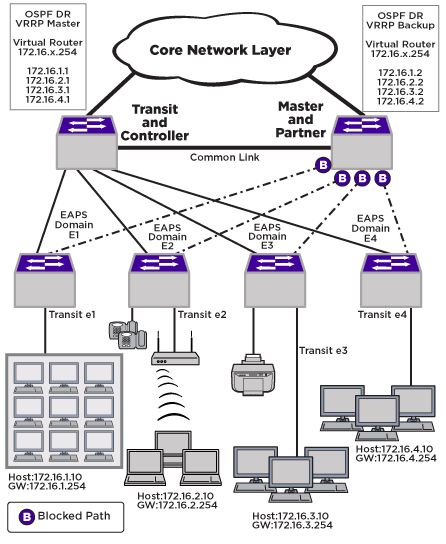This section explains how to run L3 routing services on top of EAPS (Extreme Automatic Protection Switching) as a foundation.
In this example, OSPF (Open Shortest Path First) is used as the dynamic IP routing protocol to communicate between different VLAN (Virtual LAN)s. To provide redundancy at the router level, VRRP (Virtual Router Redundancy Protocol) is used to protect against an aggregation switch failure. VRRP allows one aggregation switch to route IP traffic, and if it fails the other aggregation switch takes over the IP routing role. Each EAPS protected VLAN provides L3 connectivity to the clients by configuring IP addressing, OSPF routing, and VRRP on the aggregation switches.

IP routing is added to the design on the access network switches by configuring each EAPS protected VLAN as an OSPF interface. Because these are broadcast OSPF interfaces, we need to specify a Designated Router (DR) and Backup Designated Router (BDR). While the EAPS transit and controller node is not blocking any ports, it is configured as the OSPF DR.
The EAPS master and partner node is then configured as the BDR. Similarly, the EAPS transit and controller node is also configured as the VRRP master, which provides L3 routing to the hosts. The EAPS master and partner node is configured as the VRRP backup router for redundancy.
Using redundant aggregation switches with VRRP protects against a single point of failure at the switch level. Client devices receive non-stop IP routing services in the event of link or aggregation switch failure without any reconfiguration. OSPF provides fast convergence from any routing failures. EAPS provides the resilient L2 foundation and minimizes the occurrence of routing interface flaps or dropped OSPF neighbor adjacencies.
To configure L3 on the aggregation switches, completed the tasks described in the following sections:

 Print
this page
Print
this page Email this topic
Email this topic Feedback
Feedback